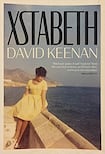
Let me tell you about Olivia Newton-John’s broken zipper. It’s one clue left unsolved by David Keenan in his transcendent shaggy dog story, Xstabeth. The novel is a quixotic achievement by one of our most exciting writers. As a rock’n’roll fairy story and myth about the Muse, it’s a triumph. I was less enamoured by its view of women.
The title refers to the LP created accidentally by failing musician Tomasz in a club in St Petersburg, resuscitating his career. The story of how Xstabeth becomes a cult album, haunting her creator, is narrated by Tomasz’s devoted daughter, 19-year-old Aneliya. In Slavic languages, her name translates as angel, a hidden clue.
Aneliya beds other daddies, generally in a pair of black knickers with a red heart on their back. By the time she’s playing “the perfect Russian whore” for a golfing Daddy in St Andrews, she’s looking like Newton-John in “the black leather trousers” in Grease.
Except every little girl who’s ever replayed Grease to inspect Sandy’s trousers in You’re the One That I Want will tell you they’re not leather. They’re unforgiving satin, so tight they had to be sewn onto Newton-John after the zip broke. It’s a pain you’ll know if you’ve circled your hips in 1950s satin or bent over a staircase to be penetrated in stilettos by an ageing Lothario. It’s the pain of women who live for the male gaze.
But the mythical properties of Xstabeth mean Aneliya isn’t bothered by broken zippers or, when one of her Daddies gets her up the duff, pregnancy sickness. Keenan’s previous novels, This Is Memorial Device and For the Good Times, conjure similar hot chicks, but not why they’re so sold on male pleasure.
Despite her author’s obsession with lingerie – and Xstabeth was written, we’re told, in the 1990s, in those first flushed days of Soho lunchtimes giggling in Agent Provocateur – Aneliya is funny and wise. Her broken sentences combine poetry with the world-weariness of a cynical teen, setting an addictive pace.
Like a witch who sees that she’s living in a fairytale, Aneliya deciphers the progress of Xstabeth as the music names, genders and regenerates herself, producing a second album and turning Tomasz and Aneliya into ghosts, of a kind. They fly to St Andrews, “which was covered in fog like an old ballad”. There Aneliya watches and is watched. She watches golf like a heroic sport, literally so, when the causeway blurs into the Elysian Fields. She watches Tomasz prepare for his next conjuring of Xstabeth.
As an expectant mother and a trainee florist, Aneliya regards her activities as “nothing”. She’s so willing a cipher of male lecherousness, or a saint, that she has a quasi-religious experience when performing for a “famous golfer” as a prostitute. Meanwhile, the men in Xstabeth are busy being “famouser” or “famous”, and in thrall to their Muse. That includes one David W Keenan, the suicidal occultist and original author, who – possibly – threw himself off a tower.
The story of Aneliya’s story, this book you hold in your hands, has spawned a cult of its own. Its pages are interpolated by academics discussing stoner notions like synchronicity and anomic aphasia, and psychobabble about alephs, neurons and proteins. Tautly edited, the sheer stylistic euphoria of Keenan’s form seems to breathe itself to life.
The real Keenan once described to me his novel about the Troubles, For The Good Times, as “an ouroboros that eats its own tail, forever”. Xstabeth is a psychedelic circle from darkness into light. If you don’t get out much – and who does, these days? – you might ascribe profound intentions to Keenan’s big questions. These resonate in the sister book to Xstabeth, The Towers The Fields The Transmitters. What makes a story? Where do art and life originate?
But those questions are here grounded in comedy (“God had much the same problem with the creation of the world”) and in fact. Tomasz worships Leonard Cohen, who loves oranges, so Tomasz’s favourite breakfast begins with an orange. Equally, the “elemental” music of Xstabeth, droning between revelatory E minor and ecstatic E seventh, convinces me because it rings with reality. A myth needs to feel real.
By contrast, even allowing for a preposterous assertion of her own emptiness, Aneliya’s service of male fantasy feels emotionally unconvincing. The beauty of young girls saving old men, especially famous artists, is a problematic beauty. Young girls grow bored of being sewn into pants with a broken zipper. We question those who make us into sex dolls.
Aneliya is probably being coy when she says, “who knows what Daddies think?” But if Daddy stopped for a second to wonder what little girls think, I’d find her more credible.














